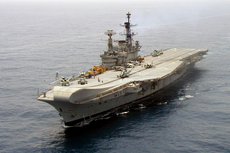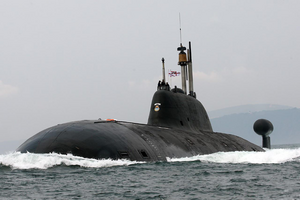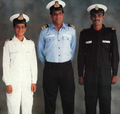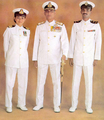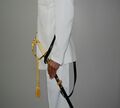Prybourne Navy
| Prybourne Navy Armada Priborn | |
|---|---|
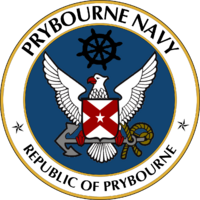 | |
| Active | November 17th, 1909 - Present |
| Country | |
| Allegiance | Prybourne Bill of Opportunities |
| Type | Navy |
| Role | Power projection, crisis response, and direct action |
| Size | 326,046 active duty personnel 107,115 reserve personnel 447 deployable ships,2,000+ aircraft |
| Part of | Prybourne National Board of Executives |
| Headquarters | Tower of Commerce |
| Motto(s) | "Born to go into harm's way, come all! Ye hell or high waters be damned!" |
| Colors | white, Red |
| March | "Fair Seas" Audio file "FairSeas.ogg" not found |
| Commanders | |
| Commander-in-Chief | Grand Nagus Andrew Cardigan |
| Executor of War | Executor of War Kenton Kaeden |
| Chief of Naval Operations | Fleet Commissioner Jacobo Berrocalt |
| Insignia | |
| flag |  |
| Jack |  |
The Pryborne Navy, often referred to as the "Grande y Felicísima Armada de Priborn", is a branch of the Prybourne Armed Forces responsible for conducting naval operations. Its stated mission is "to maintain, train and equip combat-ready Naval forces capable of winning wars, deterring aggression and maintaining freedom of the seas." The Prybourne Navy currently has nearly 500,000 personnel on active duty or in the Navy Reserve and operates 447 ships in active service and more than 2,000 aircraft.
History
The Prybourne Navy traces its origins to the Bourne Revolution Navy, which was established during the Canter Uprising after rebels seized 17 ships from the Canter Republic Navy at Monserrat Harbor. However, the fleet went largely unused resulting in it bring disbanded in 1889. The Prybourne Bill of Opportunities, though, provided the legal basis for a seaborne military force by giving the conglomerate the power "to provide, contract, and maintain a navy." Prybourne then officially began construction of its first fleet late 1909.
The 21st-century Prybourne Navy maintains a sizeable presence in Anteria. Its ability to project force onto the littoral regions of the world, engage in forward areas during peacetime, and rapidly respond to regional crises makes it an active player in Prybourean foreign and defense policy.
Current Role
Currently, the principal roles of the Prybourne Navy are:
- In conjunction with other Armed Forces of the conglomerate, act to deter or defeat any threats or aggression against the territory, people or maritime interests of Prybourne, both in war and peace;
- Project influence in Prybourne's maritime area of interest, to further the nation's political, economic and security objectives;
- In co-operation with the Navy of other Triumvirate forces, ensure good order and stability in Prybourne's maritime zones of responsibility.
- Provide maritime assistance (including disaster relief) in Prybourne's maritime neighbourhood.
Fleets
Prybourne Navy Fleets Fleets Status Parent Command Geographic Region Notes La Flota Active Prybourne Home Command Surrounding waters of Prybourne, Velnotia, and Kilowatt. Informally known as First Fleet or the Sailing First it is the main combatant in the Prybourne home defense as well as the outlying territories and Triumvirate landmasses. La Flota is headquartered in Villanueva de Torrijos, Newley, Prybourne. Second Fleet Active Northern Fleet Forces Command TBA Tasked with northern open waters and islands. Headquartered in Victoria, Hatstheput. Third Fleet Active Southern Fleet Forces Command TBA TBA Fourth Fleet Active MODOC Command TBA Operates alongside the Aziallis Naval forces as part of MODOC. Headquartered in Marateya, Maraseyo, Aziallis. Fifth Fleet Active Naval Forces Central Command TBA TBA Sixth Fleet Active Southern Fleet Forces Command TBA TBA Seventh Fleet Active Northern Fleet Forces Command TBA TBA
Ships
The names of commissioned ships of the Prybourne Navy are prefixed with the letters "CPV", designating "Conglomerate of Prybourne Vessel". The names of ships are officially selected by the Fleet Commissioner, often to honor important people or places. Additionally, each ship is given a letter-based hull classification symbol (for example, CVN or DDG) to indicate the vessel's type and number. All ships in the navy inventory are placed in the Naval Vessel Register, which is part of "the Navy List." The register tracks data such as the current status of a ship, the date of its commissioning, and the date of its decommissioning. Vessels that are removed from the register prior to disposal are said to be stricken from the register. The navy also maintains a reserve fleet of inactive vessels that are maintained for reactivation in times of need. All ships since the Navy's founding in 1909 have been made by Red Town Ship Lines.
Aircraft Carriers
An aircraft carrier is typically deployed along with a host of additional vessels, forming a carrier strike group. The supporting ships, which usually include three or four Aegis-equipped cruisers and destroyers, a frigate, and two attack submarines, are tasked with protecting the carrier from air, missile, sea, and undersea threats as well as providing additional strike capabilities themselves. Ready logistics support for the group is provided by a combined ammunition, oiler, and supply ship. Modern carriers are named after Prybournean admirals and politicians, usually Executives or the Nagus. Carriers during the 20th century carried a mix of Kilowatt and Prybourne manufactured airplanes but as of 2015 the Navy has since restocked with majority of Kilowatt-based manufacturers for airplane needs.
Cruisers
Cruisers are large surface combat vessels that conduct anti-air/anti-missile warfare, surface warfare, anti-submarine warfare, and strike operations independently or as members of a larger task force. Modern guided missile cruisers were developed out of a need to counter the anti-ship missile threat facing the Prybourne Navy. This led to the development of the AN/SPY-1 phased array radar and the Standard missile with the Aegis combat system coordinating the two. Profiteer-class cruisers were the first to be equipped with Aegis and were put to use primarily as anti-air and anti-missile defense in a battle force protection role. Later developments of vertical launch systems and the Tomahawk missile gave cruisers additional long-range land and sea strike capability, making them capable of both offensive and defensive battle operations. The Profiteer class is the only active class of cruiser. All cruisers in this class are named after battles with the exception of the admirals flag ship, the CPV Auditor.
Destroyers
Destroyers are multi-mission medium surface ships capable of sustained performance in anti-air, anti-submarine, anti-ship, and offensive strike operations. Like cruisers, guided missile destroyers are primarily focused on surface strikes using Tomahawk missiles and fleet defense through Aegis and the Standard missile. Destroyers additionally specialize in anti-submarine warfare and are equipped with VLA rockets and LAMPS Mk III Sea Hawk helicopters to deal with underwater threats. When deployed with a carrier strike group or expeditionary strike group, destroyers and their fellow Aegis-equipped cruisers are primarily tasked with defending the fleet while providing secondary strike capabilities. With very few exceptions, destroyers are named after Navy, Ground Force, and Air Force heroes.
Frigates
Prybourne frigates mainly perform anti-submarine warfare for carrier strike groups and amphibious expeditionary groups and provide armed escort for supply convoys and merchant shipping. They are designed to protect friendly ships against hostile submarines in low to medium threat environments, using torpedoes and LAMPS helicopters. Independently, frigates are able to conduct counterdrug missions and other maritime interception operations. As in the case of destroyers, frigates are named after Navy, Ground Force, and Air Force heroes.
Mine countermeasures ships
Mine countermeasures vessels are a combination of minehunters, a naval vessel that actively detects and destroys individual naval mines, and minesweepers, which clear mined areas as a whole, without prior detection of the mines. The navy has approximately a dozen of these in active service, but the mine countermeasure (MCM) role is also being assumed by the incoming classes of littoral combat ships. MCM vessels have mostly legacy names of previous Prybourne Navy ships, especially Canter-era minesweepers.
Patrol Boats
A patrol boat is a relatively small naval vessel generally designed for coastal defense duties. There have been many designs for patrol boats, though the navy currently only has a single class. They may be operated by a nation's navy or coast guard, and may be intended for marine ("blue water") and/or estuarine or river ("brown water") environments. The Navy has approximately a dozen in active service, which are mainly used in the littoral regions, but have also been used for home port patrols and drug interdiction missions. The navy's current class of patrol boats have names based on weather phenomena.
Submarines
All current and planned Prybourne Navy submarines are nuclear-powered, as only nuclear propulsion allows for the combination of stealth and long duration, high-speed sustained underwater movement that makes modern nuclear submarines so vital to a modern blue-water navy. The Prybourne Navy operates three types: ballistic missile submarines, guided missile submarines, and attack submarines. ballistic missile submarines carry the stealthiest leg of the Prybourne strategic triad. These submarines have only one mission: to carry and, if called upon, to launch the Trident nuclear missile. The primary missions of attack and guided missile submarines in the Prybourne Navy are peacetime engagement, surveillance and intelligence, special operations, precision strikes, and control of the seas. To these, attack submarines also add the battlegroup operations mission. Attack and guided missile submarines have several tactical missions, including sinking ships and other subs, launching cruise missiles, gathering intelligence, and assisting in special operations. Submarines are named after Prybourne States.
Ranks and uniform
The following graphs presents the ranks of the Prybourne Navy. These ranks generally correspond with those of other Anterian Navy rank systems, however the Prybourne Navy is a contracted force from by the Conglomerate, and does not follow traditional naming structure.
| Pay grade | O-1 | O-2 | O-3 | O-4 | O-5 | O-6 | O-7 | O-8 | O-9 | |||
|---|---|---|---|---|---|---|---|---|---|---|---|---|
| Insignia | ||||||||||||
| Title | Fleet Warden | Adjuant Fleet Lieutenant | Chief Fleet Lieutenant | Fleet Commandant | Fleet Captain | Fleet Superintendent | Brigadier Fleet Commissioner | Lieutenant Fleet Commissioner | Fleet Commissioner | |||
| Abreviation | WRD | ALT | CLT | CMDT | CPT | SRID | BCOM | LTCOM | COM | |||
| Pay grade | E-1 | E-2 | E-3 | E-4 | E-5 | E-6 | E-7 | |||||
|---|---|---|---|---|---|---|---|---|---|---|---|---|
| Insignia | ||||||||||||
| Title | Fleet Enlistee | Fleet Regular | Fleet Ace | Fleet Auxiliary | Fleet Overseer | Fleet Adjutant | Chief Fleet Adjutant | |||||
| Abreviation | ENL | REG | ACE | AUX | OVS | ADJ | CADJ | |||||
The uniform for enlisted personnel consists of a peak cap/white turban, overall white for Deck Deparmtnet staff, overall blue for Steward Department staff, and overall black for Engineering Department staff, slip on shoulder badges, black socks, and lack non-slip shoes. a beret black turban may be worn in place of peak cap/ white turban and web belt anklet and boots to be worn when ordered.
The uniform for officers consists of a peak cap/white turban, white tunic with shoulder straps for Officers and MCPO/ CPO, white tunic with arm badges for POs and below, gilt Buttons, white pants, white socks, and white shoes for brigadier Fleet Commissioners and above. Fleet Superintendent and below wear black boots. However, commissioners may wear black boots/ Black shoes when ordered. The sword shall be worn compulsorily by Fleet Superintendent and above and optionally by other officers unless otherwise ordered.
Formal dress for all personnel includes Peak cap/white turban, white full sleeved shirt, black bow tie White mess jacket, Shoulder Stripes, guilt Buttons, black summer pants, black Kamarband, black socks, and black shoes. Black summer saree and shawl scarf may be worn in lieu of white mess jacket, black summer trousers, black kamarband and black bow tie by women officers on medical grounds. However, the shoulder straps are worn on shirt when saree is worn.
